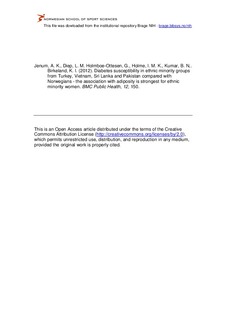| dc.description.abstract | Background
The difference in diabetes susceptibility by ethnic background is poorly understood. The aim of this study was to assess the association between adiposity and diabetes in four ethnic minority groups compared with Norwegians, and take into account confounding by socioeconomic position.
Methods
Data from questionnaires, physical examinations and serum samples were analysed for 30-to 60-year-olds from population-based cross-sectional surveys of Norwegians and four immigrant groups, comprising 4110 subjects born in Norway (n = 1871), Turkey (n = 387), Vietnam (n = 553), Sri Lanka (n = 879) and Pakistan (n = 420). Known and screening-detected diabetes cases were identified. The adiposity measures BMI, waist circumference and waist-hip ratio (WHR) were categorized into levels of adiposity. Gender-specific logistic regression models were applied to estimate the risk of diabetes for the ethnic minority groups adjusted for adiposity and income-generating work, years of education and body height used as a proxy for childhood socioeconomic position.
Results
The age standardized diabetes prevalence differed significantly between the ethnic groups (women/men): Pakistan: 26.4% (95% CI 20.1-32.7)/20.0% (14.9-25.2); Sri Lanka: 22.5% (18.1-26.9)/20.7% (17.3-24.2), Turkey: 11.9% (7.2-16.7)/12.0% (7.6-16.4), Vietnam: 8.1% (5.1-11.2)/10.4% (6.6-14.1) and Norway: 2.7% (1.8-3.7)/6.4% (4.6-8.1). The prevalence increased more in the minority groups than in Norwegians with increasing levels of BMI, WHR and waist circumference, and most for women. Highly significant ethnic differences in the age-standardized prevalence of diabetes were found for both genders in all categories of all adiposity measures (p < 0.001). The Odds Ratio (OR) for diabetes adjusted for age, WHR, body height, education and income-generating work with Norwegians as reference was 2.9 (1.30-6.36) for Turkish, 2.7 (1.29-5.76) for Vietnamese, 8.0 (4.19-15.14) for Sri Lankan and 8.3 (4.37-15.58) for Pakistani women. Men from Sri Lanka and Pakistan had identical ORs (3.0 (1.80-5.12)).
Conclusions
A high prevalence of diabetes was found in 30-to 60-year-olds from ethnic minority groups in Oslo, with those from Sri Lanka and Pakistan at highest risk. For all levels of adiposity, a higher susceptibility for diabetes was observed for ethnic minority groups compared with Norwegians. The association persisted after adjustment for socioeconomic position for all minority women and for men from Sri Lanka and Pakistan. | no_NO |
